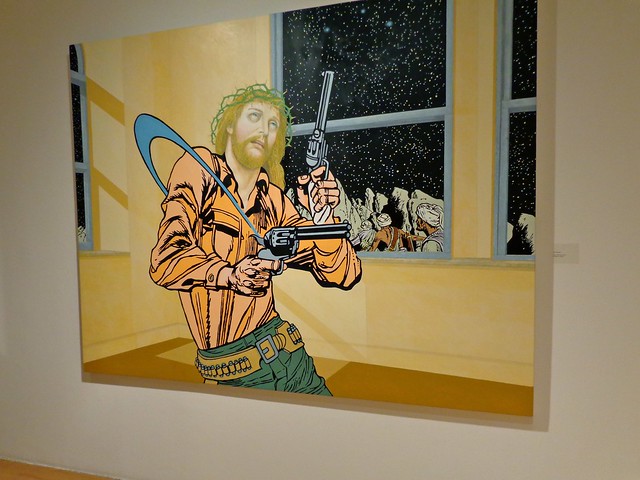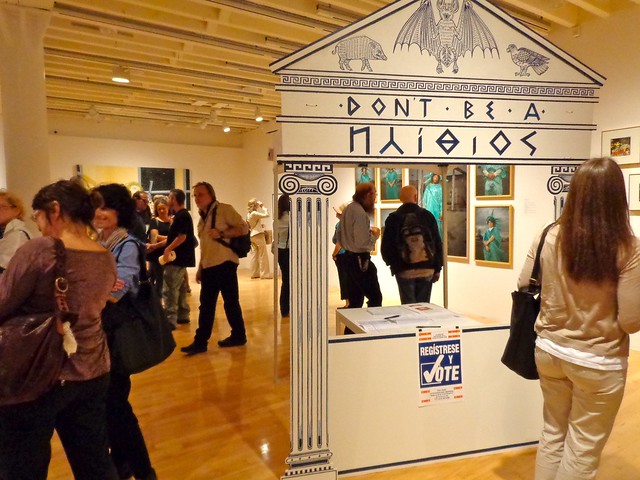Happy Election Day! I hope everyone didn’t have to wait too long in line. This was the first presidential election I’ve ever been able to vote in, so I’ve been excited all day, feverishly posting on
Seeing Politics.
I’ve been spending a big portion of my time recently considering this election and the issues surrounding it, I reviewed and interviewed artists and the curator of the Pratt Manhattan Gallery’s new show, “Party Headquarters: Art in the Age of Political Absurdity.” I was really affected by the art in this show, and have been trying to get this piece published but so far have had no luck.
So in honor of election day, please enjoy learning about what 14 artists have to say about all the hullabaloo:
 |
One Trick Pony, Jerry Kearns
Acrylic on canvas, 2012 |
A pretty bored-looking Jesus is slinging his guns around out in the cosmos while armed Middle Eastern travelers climb mountains in the background. Jerry Kearn’s painting, “One Trick Pony” is more than six square feet of acrylic irony that pairs comic book graphics with Jesus’ face painted in a 16th century fresco style. The bright colors grab your attention and the subject matter doesn’t let it go, no matter how much any ordinary American Christian would be offended.
Right now this painting is sitting at the end of a gallery room filled with other startling artworks as part of the Pratt Manhattan Gallery’s new show, “Party Headquarters: Art in the Age of Political Absurdity.” Larry Litt and Eleanor Heartney have been curating a gallery of political art for every national, state, and sometimes even mayoral election in New York for the past 20 years, but in 2012 it’s all about the money; money in oil paintings, money in acrylics, and dollar bills cut up into their own little money collages.
“There’s a certain deviousness to the money in politics now,” Larry Litt said on opening night.
 |
Duke Riley’s “Idiocracy (from the Greek ‘idiot’)”
Photo taken on opening night, 2012 |
Fourteen artists each gave their own interpretations on the state of things, and although you’d expect an Obama-rama from northeast artsy urbanites, nearly every piece criticized the system as a whole and sometimes just questioned establishments themselves, like “One Trick Pony’s” exploration of how our concept of Jesus has evolved over time. The more current political works always cast blame on both sides equally. There’s Gretta Pratt’s “Liberty Wavers,” a collection of photographs featuring low-income Americans in the same silly Statue of Liberty costume, and Mark Wagner’s money collages, cut up dollar bills with scenes or written messages like “Blood in the Water” and “Gaming the System.” Perhaps the one exception of partisanship is Peter Saul’s acrylic painting of a giant Newt Gingrich who is fist fighting little orphan Annie. Her little puppy even throws up all over Rush Limbaugh’s head in the corner.
The opening reception of “Party Headquarters” was bustling with artists and admirers, and the recessing rectangular gallery space just managed to fit all those people comfortably. The artists were excited to see their work so well received, and the show featured everything from installation sculpture and oil painting to photography and mixed media, so everyone seemed able to find something in their favorite medium that resonated.
 |
Liberty Wavers, Gretta Pratt
Photographic installation, 2010-2012 |
The sun was setting throughout the reception, letting warm light flood the white walls and columns down a gallery space that bottle-necks at the window end, and culminates in “One Trick Pony” that stands alone, stretching across the entire back wall. Besides these truly massive works, the other pieces were clustered together in arranged framed collections, featuring multiple works by the same artist from the same sort of series. The overall effect suited the space well; you were able to get to know each artist a little more – an important quality in a gallery with fourteen different opinions competing for attention.
 |
Hooray for Progress, Jade Townsend
installation/sculpture, 2011 |
In the center of the room stands a mini-popup tent that’s shaped and decorated like a Greek temple, and a table within it held four neat stacks of paper. It’s actually a functioning voter registration booth/art work called “Idiocracy (from the Greek ‘idiot’)” by New York artist Duke Riley, placing a real part of the democratic process within a reimagined Greek temple, updated for our new speedy lifestyles. Although I didn’t see anyone go near those forms on opening night, the artist’s description of the makeshift temple ends with real voter motivation: “Just as Aesop’s great fable ‘The Bat, the Birds and Beasts’ will tell: SOMETIMES YOU JUST GOTTA PICK A TEAM AND PLAY ON IT,” stressing that regardless of how disconnected we might feel from those who represent us, not voting undoes centuries of progress.
I spoke to the Pratt’s guest curator Larry Litt at the opening reception, who looked like he couldn’t have been more pleased with the turnout at the event. He was buzzing around, kissing cheeks in between answering my questions, excited to talk about this project he was still so passionate about after twenty years.
 |
Newt Gingrich vs. Orphan Annie, Peter Saul
Acrylic and alkyd on canvas, 1995 |
He said this year was different from all the others though, mostly because of how corrupt our campaign finance laws have become. Although some pieces in the show diverged, most did seem to have a similar message: money is ruining everything and we’ll never get anywhere if we keep letting it. Larry talked about the fact that no one wants to donate now because your $10 or even $1,000 will be drowned out by billions and billions of donations on the other side, so only those willing to shell out six figures or more have any sort of say, because you know, money equals speech. He seemed really concerned about this exclusion of the American public from their own government and passionate about doing something to fix it.
“We feel that this is what we can give back to the art world,” he said, going on to explain how important it is that there’s productive discourse about all the terrible places where our politics have gone wrong. Although he admitted that the artists themselves were predominately liberal, he stressed that the pieces themselves aren’t partisan, because it’s that very divide between red and blue that is stopping all the progress we could be making – and the American people know it, even if Washington is still covering it’s eyes with dollar bills.
If you’re interested in publishing, I have also written in-depth interviews with two of the artists from “Party Headquarters,” Michael D’Antuono and Jade Townsend.
For more pictures of the gallery, check out my Flickr set here.














































